
The Canadian Pacific Railway, also known simply as CPR or Canadian Pacific and formerly as CP Rail (1968–1996), was a Canadian Class I railway incorporated in 1881. The railway was owned by Canadian Pacific Railway Limited, which began operations as legal owner in a corporate restructuring in 2001.
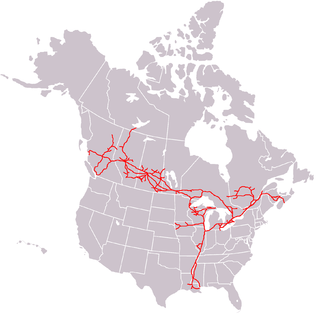
The Canadian National Railway Company is a Canadian Class I freight railway headquartered in Montreal, Quebec, which serves Canada and the Midwestern and Southern United States.

The City of Kawartha Lakes is a unitary municipality in Central Ontario, Canada. It is a municipality legally structured as a single-tier city; however, Kawartha Lakes is the size of a typical Ontario county and is mostly rural. It is the second largest single-tier municipality in Ontario by land area.
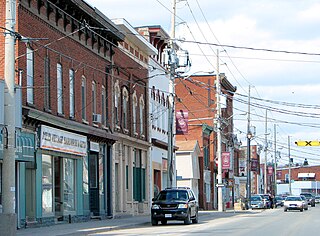
Tweed, Ontario is a community on Stoco Lake and the only urban centre of the Municipality of Tweed in Hastings County, central-eastern Ontario, Canada. It had a population of 1,701 in the 2016 census. The principal thoroughfare is Highway 37.
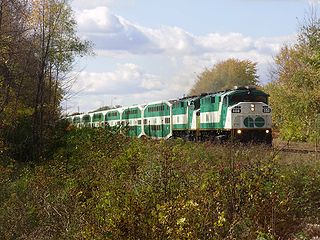
Lakeshore East is one of the seven commuter rail lines of GO Transit in the Greater Toronto Area, Ontario, Canada. It extends from Union Station in Toronto to Oshawa GO in Durham Region. Buses from Oshawa connect to communities further east in Newcastle, Bowmanville and Peterborough.

The Canadian is a transcontinental passenger train operated by Via Rail with service between Union Station in Toronto, Ontario, and Pacific Central Station in Vancouver, British Columbia, Canada.
The Ontario and Quebec Railway (O&Q) was a railway located in southern and eastern Ontario, Canada. It was initially chartered in March 1881 by managers of the Canadian Pacific Railway to run between Toronto and Perth, where it would connect, via a short branch line, to the CPR-controlled Brockville and Ottawa Railway. Construction began in 1882, and the line was completed in August 1884.

Bayview Junction is a major railway junction in southern Ontario, Canada. It is located at the intersection of three of the nation's busiest rail lines and is a popular location for railfans and trainspotters.

The Quebec City–Windsor Corridor, also known as simply the Corridor, is a Via Rail passenger train service in the Canadian provinces of Quebec and Ontario. The Corridor service area has the heaviest passenger train frequency in Canada and contributes 67% of Via's revenue.

The CN Halton Subdivision is a major railway line in Southern Ontario, Canada. It is owned and operated by the Canadian National Railway (CN).
The CN Newmarket Subdivision is a rail line in Ontario operated by Canadian National Railway (CNR). The original route runs northward from just west of Union Station in downtown Toronto, ending just south of North Bay. A short portion between Allandale in Barrie and Longford outside Orillia was lifted in 1996, and the southern section sold off in parts to Metrolinx. Metrolinx operates the southern section as their Barrie line, while CN continues to operate the northern section from Longford to North Bay. The severed northern section was never renamed, despite it no longer running through its namesake town. Access to Toronto is currently via the Bala Subdivision at Washago Junction, a short distance north of the remaining section's southern terminus, which is now used as a spur serving industries.
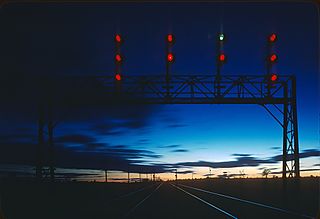
Canadian National Railway's Kingston Subdivision, or Kingston Sub for short, is a major railway line connecting Toronto with Montreal that carries the majority of CN traffic between these points. The line was originally the main trunk for the Grand Trunk Railway between these cities, although there has been some realignment of the route between these cities. The majority of the Kingston Sub runs close to the northern bank of Lake Ontario and the Saint Lawrence River.
Canadian Pacific Kansas City's Galt Subdivision is CPKC's 114.6 mile long section of its Montréal-Detroit freight corridor. It is located in Southern Ontario, Canada. Getting its name from the historic City of Galt that it passes through, the track runs from the bustling hub of Toronto, Ontario, to London, Ontario. GO Transit's Milton GO train service operates on this line from Toronto Union Station to Milton GO station. The rest of the line plays host to mixed freight and intermodal traffic, from Toronto to termini like Detroit, and Chicago. This Central Ontario line also had CP passenger rail service till 1971 when it was eliminated. Passenger rail service would be partly restored halfway through the line through the introduction of GO Transit operations in 1981 westward only as far as the Town of Milton.
The Lindsay, Bobcaygeon & Pontypool Railway (LB&P) was a short-line railway in Ontario, Canada. It was originally designed to serve sawmills in Bobcaygeon, running southward to the Ontario and Quebec Railway at Burketon, near Pontypool. Passenger service for weekender trips to the beaches on Sturgeon Lake was a major service later in the line's life.
The Georgian Bay and Seaboard Railway (GB&S) was a former short-line railway in Ontario, Canada, owned and operated by Canadian Pacific Railway (CPR). The first sections opened in 1908, and the entire 140 kilometres (87 mi) route was fully completed in 1912.

The Canadian National Railway's Beachburg Subdivision or "Beachburg Sub" for short, was part of the former Transcontinental Mainline. The Beachburg Sub connected Ottawa to Brent, Ontario.

Leaside station is a former railway station in Toronto that served Leaside and Thorncliffe Park. The Canadian Pacific Railway built the station in 1894 to serve the new community of Leaside, on a railway line leased from the Ontario and Quebec Railway.

GO Transit rail services are provided throughout the Greater Toronto and Hamilton Area (GTHA) and the Greater Golden Horseshoe. The GO Transit rail fleet consists of 90 MPI MP40 locomotives and 979 Bombardier BiLevel Coaches. In 2023, the system had a ridership of 40,807,100 passengers per year. GO Transit started on May 23, 1967, running single-deck trains powered by diesel locomotives in push-pull configuration on a single rail line along Lake Ontario's shoreline. When GO trains began operation, they ran on tracks mostly owned the two major freight railways of Canada: Canadian National (CN) and CPKC. Over time, GO Transit have acquired tracks, ensuring GO Transit has control over track maintenance and expansion. Metrolinx currently owns 80% of the GO's rail corridors.

The Canadian National Railway (CN) Bala Subdivision is a major railway line in Ontario, Canada. It runs between the provincial capital of Toronto in Southern Ontario and Capreol in Northern Ontario, where the line continues as the Ruel Subdivision. It forms part of CN's transcontinental mainline between Southern Ontario and Western Canada.
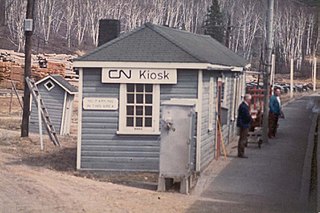
The Canadian National Railway Alderdale Subdivision was a railway line in Northeastern Ontario, Canada. It originally opened in 1915 as a part of the Canadian Northern Railway's transcontinental mainline. It connected Brent in the east with Capreol in the west. At Capreol it formed the eastern component of an east-west-south wye junction. The line's divisional point was at Alderdale.